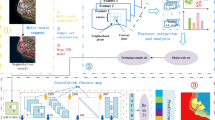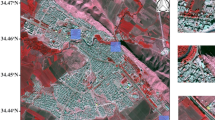Abstract
In recent years, over-exploitation has led to the accelerated destruction of rural and natural environments for urban development, making an understanding of land use and land cover changes, one of the most urgently required and important tools for urban land planning. To this end, before any land planning begins, the distribution ratio of trees for a given piece of land is determined by calculating the area of that land covered by trees. This study proposes the use of supervised machine learning methods to classify treed areas and combines unsupervised color clustering techniques to achieve optimum classification results. First, the YOLO (you only look once) classification model is used to obtain tree features and location information. The ‘K-means’ and ‘Flood fill algorithm’ methods were tested with tree classification experiments, measuring precision rate, accuracy rate, and recall rate, with shape, illumination, and angle of tree species, and color differences affecting classification results.









Similar content being viewed by others
References
United Nations (Department of Economic and Social Affairs, Population Division) (2015) World Urbanization Prospects: The 2014 Revision, (ST/ESA/SER.A/366)
Seto KC, Shepherd JM (2009) Global urban land-use trends and climate impacts. Curr Opin Environ Sustain 1(1):89–95
Sanesi G, Gallis C, Kasperidus HD (2011) Urban forests and their ecosystem services in relation to human health. In: Forests, Trees and Human Health, pp 23–40 (2011)
Aber JD (1992) Nitrogen cycling and nitrogen saturation in temperate forest ecosystems. Trends Ecol Evol 7:220–224
Escobedo FJ, Nowak DJ (2009) Spatial heterogeneity and air pollution removal by an urban forest. Landsc Urban Plan 90:102–110
Livesley SJ, McPherson GM, Calfapietra C (2016) The urban forest and ecosystem services: impacts on urban water, heat, and pollution cycles at the tree, street, and city scale. J Environ Qual 45:119–124
Salmond JA, Tadaki M, Vardoulakis S, Arbuthnott K, Coutts A, Demuzere M, Dirks KN, Heaviside C, Lim S, Macintyre H, McInnes RN, Wheeler BW (2016) Health and climate related ecosystem services provided by street trees in the urban environment. Environ Health 15:S36
Nowak DJ (2002) The effects of urban trees on air quality. USDA Forest Service, Syracuse
Nowak DJ, Hirabayashi S, Bodine A, Greenfield E (2014) Tree and forest effects on air quality and human health in the United States. Environ Pollut 193:119–129
Nowak DJ, Crane DE (2002) Carbon storage and sequestration by urban trees in the USA. Environ Pollut 116:381–389
Nowak DJ, Greenfield EJ, Hoehn RE, Lapoint E (2013) Carbon storage and sequestration by trees in urban and community areas of the United States. Environ Pollut 178:229–236
Bolund P, Hunhammar S (1999) Ecosystem services in urban areas. Ecol Econ 29:293–301
Zhao S, Da L, Tang Z, Fang H, Song K, Fang J (2006) Ecological consequences of rapid urban expansion: Shanghai, China. Front Ecol Environ 4(7):341–346
Matteucci S, Morello J (2009) Environmental consequences of exurban expansion in an agricultural area: the case of the Argentinian Pampas ecoregion. Urban Ecosyst 4:323–334
Sluiter J, Frings-Dresen M, Meijman T, Van der Beek A (2000) Reactivity and recovery from different types of work measured by catechol amines and cortisol: a systematic literature overview. Occup Environ Med 57:298–315
Kaplan S (1995) The restorative benefits of nature: toward an integrative framework. J Environ Psychol 15(3):169–182
Beyer K, Kaltenbach A, Szabo A et al (2014) Exposure to neighborhood green space and men- tal health: evidence from the survey of the health of Wisconsin. Environ Res Public Health 11:3453–3472
Chang C-Y, Chen P-K (2005) Human response to window views and indoor plants in the workplace. HortScience 40:1354–1359
Elsadek M, Jo H, Sun M, Fujii E (2013) Brain activity and emotional responses of the Japanese people toward trees pruned using Sukashi technique. Int J Agric Environ Biotechnol 6(3):344–350
Elsadek M, Sayaka S, Fujii E, Koriesh E, Moghazy E, El Abd, Fatah Y (2013) Human emotional and psycho-physiological responses to plant color stimuli. J Food Agric Environ 11:1584–1591
Tsunetsugu Y, Lee J, Park B, Tyrväinen L, Kagawa T, Miyazaki Y (2013) Physiological and psychological effects of viewing urban forest landscapes assessed by multiple measurements. Landsc Urban Plan 113:90–93
White M, Alcock I, Wheeler B et al (2013) Would you be happier living in a greener urban area? A fixed-effects analysis of panel data. Psychol Sci 24:920–928
Reklaitiene R, Grazuleviciene R, Dedele A et al (2014) The relationship of green space, depressive symptoms and perceived general health in urban population. Scand J Public Health 42(7):669–676
Hassan A, Tao J, Li G, Jiang M, Aii L, Zhihui J, Zongfang L, Qibing C (2018) Effects of walking in bamboo forest and city environments on brainwave activity in young adults. In: Evidence-Based
Shin W, Yeoun P, Yoo R, Shin C (2010) Forest experience and psychological health benefits: the state of the art future prospect in Korea. Environ Health Prev Med 15:38–47
Elsadek M, Fujii E (2014) People’s psycho-physiological responses to plantscape colors stimuli: a pilot study. Int J Psychol Behav Sci 4(2):70–78
Elsadek M, Sun M, Fujii E (2017) Psycho-physiological responses to plant variegation as measured through eye movement, self-reported emotion and cerebral activity. Indoor Built Environ 26(6):758–770
Hartig T, Evans GW, Jamner LD, Davis D, Gärling T (2003) Tracking restoration in natural and urban field settings. J Environ Psychol 23(2):109–123
Chiesura A (2004) The role of urban parks for the sustainable city. Landsc Urban Plan 68(1):29–138
MacKerron G, Mourato S (2013) Happiness is greater in natural environments. Glob Environ Change 23:992–1000
Grahn P, Stigsdotter UK (2010) The relation between perceived sensory dimensions of urban green space and stress restoration. Landsc Urban Plan 94(3):264–275
Ernstson H (2012) The social production of ecosystem services: a framework for studying environmental justice and ecological complexity in urbanized landscapes. Landsc Urban Plan 109(1):7–17
Kong F, Yin H, James P, Hutyra L, He H (2014) Effects of spatial pattern of greenspace on urban cooling in a large metropolitan area of eastern China. Landsc Urban Plan 128:35–47
Abreu-Harbich L, Labaki LC, Matzarakis A (2015) Effect of tree planting designed tree species on human thermal comfort in the tropic. Landsc Urban Plan 138:99–109
Hsieh C-M, Jan F-C, Zhang L (2016) A simplified assessment of how tree allocation, wind environment, and shading affect human comfort. Urban For Urban Green 18:126–137
Höjer M, Ahlroth S, Dreborg KH, Ekvall T, Finnveden G, Hjelm O, Hochschorner E, Nilsson M, Palm V (2008) Scenarios in selected tools for environmental systems analysis. J Clean Prod 16:1958–1970
Moss R, Edmonds J, Hibbard K, Manning M, Rose S, van Vuuren D, Carter T, Emori S, Kainuma M, Kram T, Meehl G, Mitchell J, Nakicenovic N, Riahi K, Smith S, Stouffer R, Thomson A, Weyant J, Wilbanks T (2010) The next generation of scenarios for climate change research and assessment. Nature 463:747–756
Brown DG, Walker R, Manson S, Seto K (2004) Modeling land-use and land-cover change. In: Land Change Science, pp 395–409
Weinhaus FM, Devich RN (1999) Photogrammetric texture mapping onto planar polygons. Graph Models Image Process 61(2):63–83
Ghamisi P, Benediktsson JA (2015) Feature selection based on hybridization of genetic algorithm and particle swarm optimization. IEEE Geosci Remote Sens Lett 12(2):309–313
MacQueen J (1967) Some methods for classification and analysis of multivariate observations. In: Proceedings of the Fifth Berkeley Symposium on Mathematical Statistics and Probability, vol 1, no 14, pp 281–297
Achanta R, Shaji A, Smith K, Lucchi A, Fua P, Süsstrunk S (2012) SLIC super pixels compared to state-of-the-art superpixel methods. IEEE Trans Pattern Anal Mach Intell 34(11):2274–2282
Ball GH, Hall DJ (1965) ISODATA, a novel method of data analysis and classification. Tech. Rep. Stanford University, Stanford
Bezdek JC, Ehrlich R, Full W (1984) FCM: the fuzzy c-means clustering algorithm. Comput Geosci 10(2–3):191–203
Romero A, Gatta C, Camps-Valls G (2016) Unsupervised deep feature extraction for remote sensing image classification. IEEE Trans Geosci Remote Sens 54(3):1349–1362
Jackson Q, Landgrebe DA (2002) Adaptive Bayesian contextual classification based on Markov random fields. IEEE Trans Geosci Remote Sens 40(11):2454–2463
Bengio Y, Courville A, Vincent P (2013) Representation learning: a review and new perspectives. IEEE Trans Pattern Anal Mach Intell 35(8):1798–1828
Redmon J, Farhadi A (2019) Yolov3: an incremental improvement, arXiv preprint arXiv:1804.02767
MacQueen JB (1967) Some methods for classification and analysis of multivariate observations. In: Proceedings of the Fifth Berkeley Symposium on Mathematical Statistics and Probability, 1, pp 281–297
Xia G-S, Hu J, Hu F, Shi B, Bai X, Zhong Y, Zhang L (2017) AID: a benchmark dataset for performance evaluation of aerial scene classification. IEEE Trans Geosci Remote Sens 55(7):3965–3981
Acknowledgements
Funding was provided by Ministry of Science and Technology, Taiwan (Grant No. MOST 107-2221-E-025-007).
Author information
Authors and Affiliations
Corresponding author
Additional information
Publisher's Note
Springer Nature remains neutral with regard to jurisdictional claims in published maps and institutional affiliations.
Rights and permissions
About this article
Cite this article
Lin, C.H., Yu, C.C., Wang, T.Y. et al. Classification of the tree for aerial image using a deep convolution neural network and visual feature clustering. J Supercomput 76, 2503–2517 (2020). https://doi.org/10.1007/s11227-019-03012-3
Published:
Issue Date:
DOI: https://doi.org/10.1007/s11227-019-03012-3




